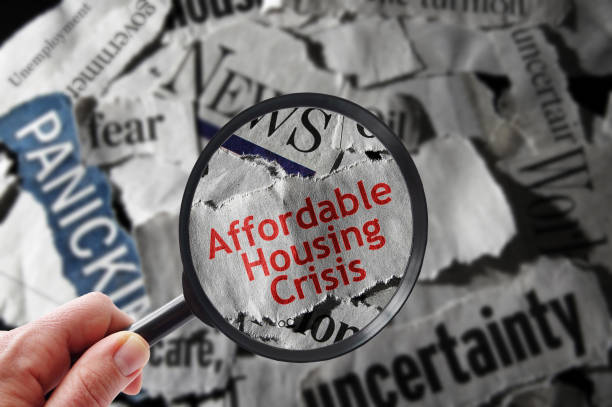Why Is Housing in Los Angeles So Expensive in 2025?
In 2025, Los Angeles remains one of the most expensive housing markets in the country. Despite higher interest rates and a slower pace of migration, prices for both homes and rentals have not fallen significantly. Instead, families and workers are still squeezed by costs that rise faster than incomes.
Table of Contents
ToggleWhat makes LA so costly? The answer lies in a combination of history, policy, geography, and economics. The roots stretch back decades. Yet the consequences feel sharper today because the supply of affordable homes has not caught up with demand.
Quick snapshot of LA housing in 2025:
| Factor | Current Situation (2025) | Impact on Affordability |
|---|---|---|
| Median home price | Around $930,000 | Far above what most local incomes can support |
| Median rent | About $2,900/month for a 2-bedroom | Renters spend 40–50% of income on housing |
| Vacancy rate | ~3.5% | Extremely tight rental market |
| Annual new housing units | 16,000–18,000 | Still below regional need of 50,000+ |
These figures show why affordability is a crisis, not just an inconvenience. To understand how LA reached this point, we need to look at the roots of the problem and the persistent shortage of housing.
The Historical Roots of LA’s Housing Crisis
The affordability problem did not appear overnight. It was shaped by decades of choices, policies, and cultural attitudes.
Key historical factors include:
Post-WWII suburban expansion
Freeways and subdivisions created rapid growth.
Homeownership soared, but mostly for white middle-class families.
Redlining and housing discrimination
Communities of color were systematically excluded from prime neighborhoods.
This blocked access to affordable mortgages and wealth-building opportunities.
Proposition 13 (1978)
Froze property tax increases, protecting homeowners.
Reduced incentives for cities to approve new housing (less tax revenue compared to retail).
Restrictive zoning
Large parts of LA remain zoned for single-family homes only.
Limits density and keeps supply artificially low.
Example: Even today, about 75% of residential land in Los Angeles is zoned for single-family homes. That means apartments, duplexes, or townhouses are often not allowed where land is available.
📊 Quick Snapshot of LA Housing in 2025
Lasting effects:
Generational wealth gaps remain due to historic exclusion.
Cities prefer revenue from retail developments rather than housing.
Homeowners stay put, benefiting from low property taxes, while newcomers face steep entry costs.
Supply Shortages: Why Los Angeles Can’t Build Enough Homes
At the center of the crisis is one simple fact: there are not enough homes for the people who want to live in Los Angeles.

Why supply falls short
Geographic limits
Mountains, deserts, and the ocean constrain outward expansion.
Unlike cities with open land, LA must densify — but zoning blocks much of it.
Local resistance (NIMBYism)
Residents often oppose apartments or new housing near them.
Common objections: traffic, parking, neighborhood character.
Complicated permitting
Developers face years of review, appeals, and community hearings.
Delays add millions to project costs, which trickle down to renters and buyers.
Rising construction costs
Material costs rose sharply in the early 2020s.
Labor shortages continue into 2025, making projects more expensive.
Recent policy changes
California has passed reforms meant to ease the shortage:
SB 9 (2022): Allows homeowners to split lots or build duplexes.
SB 10: Encourages small multifamily housing near transit.
ADU rules: “Granny flats” and backyard homes are now legal and more common.
Impact so far:
ADU construction has helped thousands of families add income or house relatives.
However, overall new units (16k–18k per year) remain far below the estimated 50k+ needed to stabilize prices.
Table: Housing Supply in Los Angeles (2020 vs. 2025)
| Year | New Units Built | Regional Need | Gap |
|---|---|---|---|
| 2020 | ~12,000 | 50,000+ | 38,000 |
| 2023 | ~15,000 | 50,000+ | 35,000 |
| 2025 | ~18,000 | 50,000+ | 32,000 |
Even with progress, the gap is still enormous. As long as demand remains high and supply trails far behind, prices will stay elevated.
Demand Pressures in 2025: Why People Still Want to Live in LA
Even with high prices, demand for housing in Los Angeles has not disappeared. Instead, the region remains attractive for jobs, education, and lifestyle. This strong demand collides with limited supply, pushing costs higher.
Key demand drivers in 2025:
Job market strength
Tech, entertainment, healthcare, and green energy industries continue to grow.
Remote work has slowed outward migration, but many still need to live near LA.
Population resilience
Los Angeles County’s population dipped slightly in 2021–2023 but stabilized by 2025.
Younger workers, immigrants, and students keep housing demand strong.
Cultural and lifestyle appeal
Beaches, climate, and universities still draw people worldwide.
International buyers also see LA real estate as a long-term investment.
Table: LA Demand Drivers (2025)
| Driver | Current Trend | Housing Impact |
|---|---|---|
| Jobs | Growth in tech & green sectors | Higher incomes but concentrated demand |
| Immigration | Return of international students & workers | Expands rental market |
| Lifestyle | Climate, culture, global appeal | Maintains long-term demand |
Bottom line: Demand pressures mean that even small gaps in supply have an outsized impact on prices.
The Role of Zoning and Land Use Laws
Zoning laws shape where and how much housing can be built. In Los Angeles, restrictive rules remain one of the strongest barriers to affordability.
🏡 Why is Housing in Los Angeles So Expensive?
Redlining, Prop 13, restrictive zoning
Mountains, ocean, wildfire zones
High demand, low supply, investor activity
Slow reforms, NIMBY resistance
Facts about zoning in LA (2025):
About 75% of residential land is zoned for single-family homes.
Apartment buildings, duplexes, and townhouses are banned in many neighborhoods.
Commercial corridors often sit underused while nearby renters face overcrowding.
Consequences of restrictive zoning:
Limited density → prevents the addition of enough units to meet demand.
Higher land costs → since fewer lots can host apartments, the price per unit rises.
Segregation effects → wealthier homeowners block multifamily housing in their areas. Hence, keeping lower-income households out.
Recent policy reforms:
SB 9 allows homeowners to split lots, but uptake is modest.
Transit-Oriented Development (TOD) incentives promote higher density near rail stations.
City-level inclusionary zoning requires some affordable units in new projects.
Yet, change is slow. For every new unit legalized, opposition often delays or shrinks projects.
Construction Costs and Development Barriers
Even when zoning allows new housing, construction costs often make projects unfeasible. Developers must deal with expensive materials, high labor costs, and lengthy permitting.

Key construction challenges in 2025:
Material costs remain elevated
Lumber, steel, and cement prices rose sharply during the pandemic.
Though slightly lower in 2025, they are still 25–30% higher than pre-2020.
Labor shortages
Construction workers are aging out, and fewer young workers enter the trade.
Immigration restrictions have reduced the supply of skilled labor.
Regulatory delays
Environmental reviews, community hearings, and lawsuits add years to projects.
Carrying costs during delays drive up final housing prices.
Table: Major Cost Drivers in LA Construction (2025)
| Factor | Change Since 2020 | Effect on Housing Prices |
|---|---|---|
| Lumber & steel | +25–30% | Higher building costs passed to buyers |
| Labor | Shortage of ~20% workforce | Fewer projects completed |
| Permitting | 2–5 years average | Delays increase financing costs |
Example of cost escalation:
A mid-sized apartment project in 2020 might have cost $250,000 per unit to build. In 2025, the same project can exceed $350,000 per unit once materials, delays, and interest rates are factored in. Check the forecast report here: National Apartment Research Report
Takeaway: Even with high demand and zoning approval, barriers slow housing growth.
Investor Activity and Speculation
Housing in Los Angeles has long attracted investors, from local landlords to global corporations. By 2025, this trend remains strong, though shifting interest rates and regulations have reshaped the field.
Who are the key players in 2025?
Institutional investors: Large firms purchase single-family homes to convert them into rentals.
Foreign buyers: Still active, though slowed by currency fluctuations and capital controls abroad.
Local investors: Individuals or small companies buying multifamily buildings. Thus, often flipping or holding long term.
Table: Investor Dynamics in LA (2025)
| Investor Type | Strategy | Housing Impact |
|---|---|---|
| Institutions | Bulk buying SFRs for rentals | Reduces ownership options for families |
| Foreign buyers | Luxury condos & trophy properties | Pushes luxury pricing up |
| Local investors | Duplexes, triplexes, flips | Competes with first-time buyers |
Why it matters:
Investors can outbid regular families with cash offers.
Properties are often removed from the starter-home market.
Rent-focused ownership models shift the balance away from affordability.
However, higher interest rates in 2024–2025 cooled speculative flipping. Yet, the long-term presence of institutional owners continues to shape LA’s housing market.
📐 LA Housing Affordability Estimator
Enter your income to estimate how much rent or mortgage you could afford in LA (based on 30% rule).
Ready to Navigate LA’s Housing Market? 🏙️
Whether you’re buying, selling, or developing property in Los Angeles, expert guidance can save you time and money.
📞 Contact JDJ Consulting TodayRental Market Pressures
Renting is the reality for most Angelenos, and by 2025, rental affordability has become a crisis of its own. Median rent remains high, often consuming over 40% of household income for middle-income families.
Current rental trends (2025):
Median rent for a 1-bedroom: $2,300–$2,600/month.
Median rent for a 2-bedroom: $3,000–$3,400/month.
Vacancy rates: Hovering around 4%, meaning landlords hold strong pricing power.
Key drivers of high rent:
Strong demand → Students, young professionals, immigrants, and families competing.
Limited new construction → Supply is not keeping pace with demand.
Investor ownership → Preference for rent maximization strategies.
Table: Rent Burden in Los Angeles (2025)
| Income Group | % of Income Spent on Rent | Outcome |
|---|---|---|
| Low-income (<$40k) | 60–70% | Risk of eviction, overcrowding |
| Middle-income ($60–90k) | 40–45% | Little savings for home purchase |
| High-income (>$120k) | 25–30% | Manageable but competes for mid-tier rentals |
Effects on residents:
Delayed homeownership, as renters cannot save down payments.
Rising homelessness, with LA County reporting over 78,000 unhoused residents in 2025.
Longer commutes as families move farther out for lower rents.
📊 Home Price-to-Income Ratios (2025)
Policy Efforts and Housing Programs
Governments at city, county, and state levels have tried to address LA’s housing issues. By 2025, the results are mixed: some progress, but challenges remain.
Major policies in effect:
Rent stabilization
City-level caps limit annual rent increases for older units.
Helps existing tenants but reduces landlord incentives to maintain or expand stock.
Affordable housing bonds
Funding to support construction of below-market housing.
2023–2025 bonds have added several thousand units, but far below the need.
Transit-Oriented Communities (TOC) program
Incentivizes denser housing near Metro lines.
Some success, but still slowed by local opposition.
Homelessness initiatives
Expansion of “Housing First” programs.
New modular housing projects aim for quicker delivery.
Table: LA Housing Policy Outcomes (2025)
| Policy | Intended Goal | 2025 Outcome |
|---|---|---|
| Rent control | Protect tenants | Helps existing renters, limits new construction |
| Bonds for affordable housing | Build more units | Added units but supply gap persists |
| TOC incentives | Encourage density | Works in some areas, blocked in others |
| Homeless housing | Reduce street homelessness | Growing but demand outpaces supply |
Bottom line: Policy efforts provide some relief, but they remain incremental compared to the scale of the crisis.
Social Impacts of High Housing Costs
Housing affordability in Los Angeles is not just an economic issue; it deeply affects the city’s social fabric. By 2025, many communities are struggling with displacement and shrinking opportunities for youngsters.
How high housing costs shape daily life:
Generational squeeze: Young adults live longer with parents because they cannot afford independent housing.
Displacement of working-class families: Long-term residents are priced out of historic neighborhoods like Boyle Heights and Highland Park.
Declining community stability: Frequent moves disrupt schools, friendships, and local networks.
Table: Social Outcomes of Expensive Housing (2025)
| Social Group | Impact of High Housing Costs | Long-Term Risk |
|---|---|---|
| Young adults (20–35) | Delayed marriage, children, independence | Aging population, fewer future homeowners |
| Middle-income families | Overcrowding, moving to Inland Empire | Erosion of middle class in LA |
| Seniors | Rising rent on fixed incomes | Homelessness and reliance on public aid |
Key takeaway: Housing is not just about where people live — it determines whether communities thrive or fracture. In LA, rising costs are pushing many toward instability and uncertainty.
Environmental and Geographic Constraints
Los Angeles faces unique geographic challenges that limit how much housing can realistically be built. Unlike flat metropolitan areas, LA is bordered by mountains, the ocean, and protected lands. By 2025, climate change has further complicated housing development.
Environmental barriers:
Wildfire zones → Hillside developments face stricter building rules.
Coastal restrictions → California’s Coastal Commission limits large-scale construction near beaches.
Earthquake safety → Retrofitting requirements make construction more expensive.
Water supply → Ongoing drought and climate pressures limit sustainable growth.
Table: Geographic Limits to Housing in LA (2025)
| Constraint | Example | Effect on Housing |
|---|---|---|
| Wildfire risk | Santa Monica Mountains | Higher insurance, fewer approvals |
| Coastal rules | Venice, Malibu | Slowed or blocked development |
| Seismic codes | All new high-rises | Increases construction cost |
| Water scarcity | Entire metro region | Restricts large-scale housing expansion |
Result: Even with policy reform, LA cannot build endlessly. Environmental and geographic realities mean new housing will always face hurdles.
Comparing Los Angeles with Other Cities
Looking at LA in isolation doesn’t give the full picture. Comparing it to other U.S. cities shows why the housing crisis feels especially severe here in 2025.
Housing Affordability Across Cities (2025)
| City | Median Home Price | Median Household Income | Price-to-Income Ratio |
|---|---|---|---|
| Los Angeles | $850,000 | $75,000 | 11.3 |
| San Francisco | $1.25M | $110,000 | 11.4 |
| New York City | $750,000 | $95,000 | 7.9 |
| Austin | $475,000 | $85,000 | 5.6 |
| Houston | $325,000 | $78,000 | 4.1 |
Analysis:
LA’s ratio of home price to income is among the highest in the nation.
Unlike Texas cities, LA faces zoning limits and geographic barriers.
Compared to New York, LA has less vertical density, limiting supply.
What stands out in 2025:
San Francisco and LA remain the hardest markets for middle-class buyers.
Sunbelt cities like Houston and Austin attract families leaving California for affordability.
Los Angeles continues to struggle balancing growth with environmental and social pressures.
Policy Efforts and Government Responses
By 2025, policymakers in Los Angeles and across California have been forced to respond to the housing crisis. While progress is uneven, new laws try to balance affordability, environmental safety, and people needs.
Recent government measures:
SB 9 (California Home Act) → Allows some single-family lots to be split, creating more housing opportunities.
Affordable housing mandates → Developers must include a percentage of low-income units in larger projects.
Rent stabilization → Los Angeles continues rent control policies to protect tenants from rapid increases.
City-led housing projects → LA has invested in modular housing and adaptive reuse of office buildings.
Table: Policy Responses in LA (2025)
| Policy/Program | Goal | Challenges |
|---|---|---|
| SB 9 lot splits | Increase density in suburbs | Local opposition, fire zone limits |
| Rent control | Protect existing tenants | Discourages some landlords from investing |
| Modular housing | Rapidly add affordable units | Land and permitting delays |
| Office-to-housing conversion | Use empty office towers | Expensive retrofitting, zoning hurdles |
Key point: While these policies help, they are often piecemeal. Without large-scale investment and zoning reform, housing costs remain high.
What Solutions Could Work for Los Angeles?
The future of housing in LA depends on bold decisions. By looking at successful approaches elsewhere, LA can consider paths forward.

Potential solutions:
Build more mid-rise housing along transit corridors.
Streamline permitting to cut down years of delays for new developments.
Expand public-private partnerships for affordable housing projects.
Support first-time buyers with tax credits and down-payment help.
Regional cooperation so surrounding counties share housing growth responsibilities.
Bullet summary of promising approaches:
Balance density with design to keep neighborhood character.
Incentivize developers with tax breaks for affordable units.
Encourage community land trusts to keep housing permanently affordable.
Invest in infrastructure (transit, water, power) to support higher density.
Reality check: None of these solutions are quick. But if combined, they could shift LA toward a more balanced housing market by the 2030s.
The Future of Housing in Los Angeles (2025 and Beyond)
Housing in Los Angeles will remain expensive in the short term. However, demographic, technological, and policy shifts may reshape the market over time.
Trends to watch:
Remote work → Some workers continue moving inland for cheaper housing, reducing city demand.
AI in real estate planning → Cities may use technology to speed up permit approvals.
Climate adaptation → Wildfire, drought, and heat risks will shape where housing is possible.
Generational turnover → As Baby Boomers downsize or sell, more homes may reach the market.
Table: Outlook for LA Housing
| Factor | Short-Term (2025–2030) | Long-Term (2030–2040) |
|---|---|---|
| Prices | Stay high, slow growth | Moderate if supply expands |
| Rent | Rising, pressure on middle class | Could stabilize with new stock |
| Supply | Incremental additions | Larger gains with zoning reform |
| Equity | Wealth gap remains wide | May narrow if more ownership paths emerge |
Takeaway: Housing affordability will not resolve overnight. Yet incremental reforms and new housing models may slowly improve conditions if the city acts decisively.
📝 Quick Quiz: LA Housing in 2025
Q: About what percentage of LA’s residential land is zoned for single-family homes?
Conclusion
Housing in Los Angeles is expensive in 2025. The reasons are layered: limited supply, strict zoning, high demand, and natural barriers. These problems have built up for decades and will take time to fix.
The effects reach across society. Families get displaced. Young people delay milestones like buying a home. Communities lose stability. At the same time, risks like wildfires, drought, and earthquakes limit how far the city can expand.
Still, there are ways forward. Policies like SB 9, converting offices into homes, and building affordable housing all help. LA can also learn from other cities by allowing more density, speeding up permits, and supporting buyers.
The road will be long. Yet the 2025 conversation is clearer than ever: housing is not only an economic issue. It is the base for community, opportunity, and the future of Los Angeles.
If you’re planning to buy, sell, or develop property in Los Angeles, expert guidance matters. At JDJ Consulting Group, we help clients with zoning, permits, and investments so they can make smart choices in today’s market.
Call us at (818) 793-5058 or contact us online to discuss your project or housing goals in Los Angeles.
FAQs: Housing in Los Angeles So Expensive in 2025
Is housing in Los Angeles still expensive in 2025?
Yes. Even with higher interest rates slowing down some buyers, Los Angeles remains one of the most expensive housing markets in the country. Home prices and rents have not dropped significantly, and affordability continues to be a major challenge for both first-time buyers and long-term residents.
What’s driving the high home prices in LA?
Housing prices in Los Angeles are influenced by several overlapping factors:
Limited housing supply caused by zoning restrictions and scarce land.
Strong demand from buyers, investors, and renters.
High construction costs that make new developments expensive.
Economic strength in industries like entertainment and tech that draw high-income workers.
Together, these keep LA’s housing market competitive and expensive.
Why is housing supply so constrained in Los Angeles?
Los Angeles has struggled to add enough housing for decades. The main reasons include:
Large portions of land are zoned for single-family homes only.
New development often faces lengthy approval processes and high fees.
Community pushback, or “NIMBYism,” often slows or stops projects.
Geography limits expansion, with mountains and the ocean boxing in the city.
All of this makes it harder to build new homes quickly.
How much have construction costs increased in California?
Construction costs in California are some of the highest in the nation.
“Soft costs,” such as permitting, design, and legal fees, are significantly higher compared to other states.
Labor shortages and strict building codes add to the expense.
Materials like lumber and steel remain expensive after years of supply chain issues.
This makes every new housing unit costlier to build, and those costs are passed on to buyers and renters.
How have interest rates affected affordability?
Interest rates in 2025 remain high compared to earlier years. While this has cooled demand slightly, it has also raised the monthly cost of mortgages. Many buyers who could afford a home when rates were lower are now priced out, leading to:
Fewer qualified buyers.
Higher barriers to entry for first-time homeowners.
More pressure on the rental market as people delay buying.
What percentage of Californians can still afford a median-priced home?
The number of households that can afford a median-priced home is very small. In fact:
Only about 15% of Californians can qualify for a typical single-family home.
Condominiums are slightly more accessible, but still difficult, with about 1 in 4 households able to afford them.
This affordability gap highlights the severity of the housing crisis.
Have recent wildfires affected LA’s housing costs?
Yes, wildfires have added pressure to an already strained housing market. Displacement from destroyed homes has pushed many families into rentals, which increases demand and drives up rents. Insurance premiums have also risen in fire-prone areas, further raising housing costs for owners.
What long-term effects do wildfires have on housing?
Wildfires don’t just destroy homes—they reshape housing markets. Long-term impacts include:
Higher rebuild costs, which lead to higher property values.
Increased insurance premiums, sometimes making areas unaffordable.
Risk of “climate gentrification,” where lower-income families are pushed out of rebuilding areas.
This makes affordable housing even more scarce.
Are there reforms to ease LA housing shortages?
Yes, California has passed several housing reforms aimed at increasing supply:
SB 9 allows some single-family lots to be split into two.
SB 10 makes it easier for cities to approve small multifamily housing projects.
ADU (Accessory Dwelling Unit) laws now allow homeowners to add secondary units more easily.
These reforms help, but progress is slow compared to the scale of the shortage.
How does LA compare to other cities on affordability?
Los Angeles ranks among the least affordable housing markets in the U.S.
The price-to-income ratio is far higher than cities like Houston, Dallas, or Phoenix.
LA is closer in cost to San Francisco and New York, even though wages here have not kept pace with home prices.
What impact do investors have on LA housing?
Investors play a significant role in LA’s housing dynamics.
Institutional buyers purchase single-family homes to convert them into rentals.
House-flipping and short-term rentals reduce the supply of homes for long-term buyers.
This often squeezes out first-time buyers, who cannot compete with cash offers.
Are policy efforts making a difference yet?
Policy changes are starting to show results, but the impact is slow. Affordable housing bonds, tenant protections, and zoning reforms are helping, but they have not yet closed the massive gap between demand and supply. The housing shortage is so deep that it will take years of consistent building and reform to see significant affordability improvements.
Error: Contact form not found.






